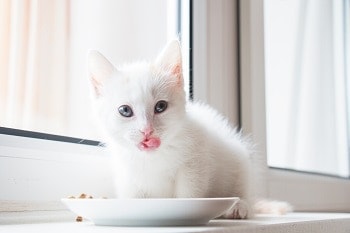
One type of kitten food that’s becoming more popular is grain-free kitten food. Grains are often used as a filler in cat food, and as obligate carnivores, your little tiger doesn’t actually need them, anyway. But with so many different types of grain-free food to choose from, where do you even start?
We’ve taken time to delve into the huge variety of grain-free kitten foods on the market today, and we have selected our top 10 to include in our reviews list. Whether you’re looking for a premium option or something a little more budget-friendly, we’ve rounded up the best options.
A Quick Comparison of Our Favorites (Updated in 2024)
| Image | Product | Details | ||
|---|---|---|---|---|
| Best Overall |
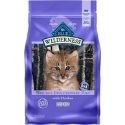
|
Blue Buffalo Wilderness Kitten |
|
CHECK PRICE |
| Best Value |

|
Iams Perfect Portions Healthy Kitten |
|
CHECK PRICE |
| Premium Choice |

|
Wellness CORE Grain-Free Kitten Formula |
|
CHECK PRICE |
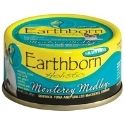
|
Earthborn Holistic Monterey Medley |
|
CHECK PRICE | |

|
Wellness Complete Health Kitten Formula |
|
CHECK PRICE |
The 9 Best Grain-Free Kitten Foods
1. Blue Buffalo Wilderness Kitten Grain-Free Dry Food – Best Overall
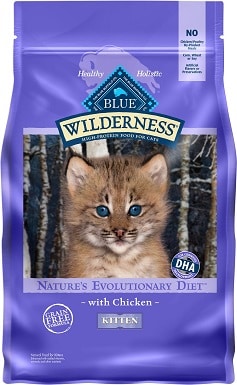
If you’re looking for the best grain-free food for your precious kitten, then you can’t go wrong with Blue Buffalo Wilderness Kitten Grain-Free Dry Food. With high levels of protein because this is packed full of real chicken, your kitten will develop healthy, strong muscles. Kittens need fatty acids DHA and ARA to help their eye and brain development, so you’ll be pleased to know that this includes plenty of those!
This dry kitten food is also rich in all the essential nutrients and vitamins that your kitten needs. There’s plenty of omega fatty acids, thanks to the inclusion of flaxseeds and fish meal. This also has antioxidants to help your kitty develop a strong immune system, so they can take whatever the world throws their way.
- Choose from two bag sizes
- Contains 40% protein
- Real chicken is the first ingredient
- No meat by-products
- Includes pea protein, which can trigger allergies
2. Iams Perfect Portions Healthy Kitten Grain-Free Food – Best Value
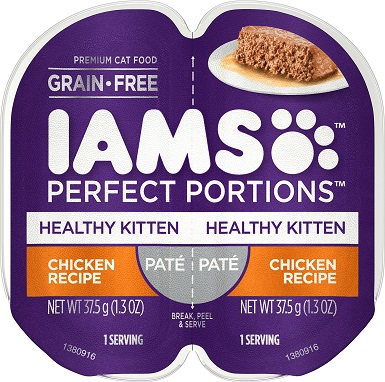
As the best grain-free kitten food for the money, you can’t beat the Iams Perfect Portions Healthy Kitten Grain-Free food. This pate-style wet food is made in the U.S.A. and uses a blend of high-quality ingredients. It is packed full of DHA, an essential nutrient found in mother’s milk. It is also rich in antioxidants, including vitamin E, helping your kitten’s immune system develop.
This fresh wet food doesn’t contain any artificial preservatives and lists chicken as the first ingredient. The plastic, single-serve trays that this wet food comes in are certainly easy to use, but they do result in more waste than we’d like. That’s the only reason this missed out on our top spot!
- Chicken as the first ingredient
- Contains 9% protein
- Aids hydration
- Veterinarian recommended
- Plastic trays result in a large amount of waste
3. Wellness CORE Grain-Free Kitten Formula Dry Food – Premium Choice
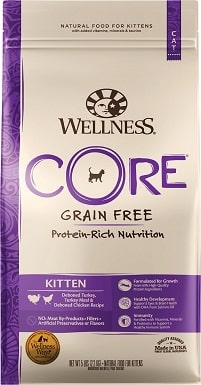
If you’re looking for premium grain-free kitten food for your pampered pet, we highly recommend the Wellness CORE Grain-Free Kitten Formula Dry Food. This dry kibble contains deboned turkey and whitefish as the first two ingredients, meaning it is packed full of protein to help your kitten grow strong and healthy.
As well as plenty of protein, this high-quality food also contains everything else that your kitten needs in terms of nutrients, from DHA fatty acids to probiotics, vitamins, and minerals. You can rest safe in the knowledge that your kitten is getting everything they need to thrive.
- Turkey as the first ingredient
- Contains 45% protein
- Fortified with probiotics
- Made in the U.S.A.
- Expensive
- Includes peas, which can trigger allergies
4. Earthborn Holistic Monterey Medley Grain-Free Kitten Food
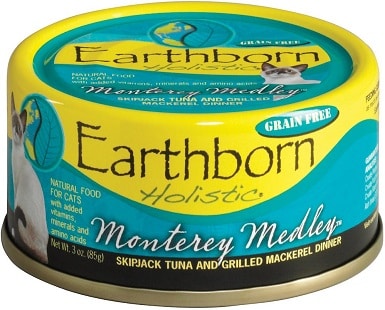
If your kitten loves fish, then the Earthborn Holistic Monterey Medley Grain-Free Kitten Food is going to be their new favorite. Inspired by the diet of a true carnivore, this wet food contains plenty of protein to fuel your kitten’s adventures. As a bonus, it’s also suitable for adult cats, which makes managing a multi-cat household a bit easier.
The first three ingredients in this chunky wet food are fish broth, skipjack tuna, and mackerel. Of course, this is also packed full of vitamins, omega fatty acids, and taurine. The thick, gravy-like sauce is extremely palatable and has the bonus of helping your kitten stay hydrated.
- Available in 3-ounce or 5.5-ounce cans
- Provides hydration from fish broth
- Includes guar gum
- Small cans create a great deal of waste
5. Wellness Complete Health Kitten Formula Grain-Free Canned Food
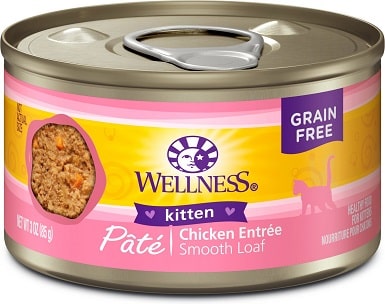
The Wellness Complete Health Kitten Formula Grain-Free Canned Food provides protein-rich nutrition to help nourish your kitten as they grow and mature. With chicken as the first ingredient, this wet food also contains chicken liver, chicken broth, and a blend of healthy fruits and vegetables.
As well as plenty of meat, this kitten food has all the supplementary vitamins and minerals that your kitten needs to thrive, from taurine to omega fatty acids, antioxidants, and fish oil. Your kitten will be nourished and hydrated. If you have multiple kittens, you’ll find that you’ll go through quite a few of these small 3-ounce cans, and unfortunately, they’re not available in a larger size.
- Chicken as the first ingredient
- No fillers
- Includes antioxidants
- Made in the U.S.A.
- Cans are small
- Contains guar gum
6. Merrick Purrfect Bistro Grain-Free Healthy Kitten Recipe Dry Food
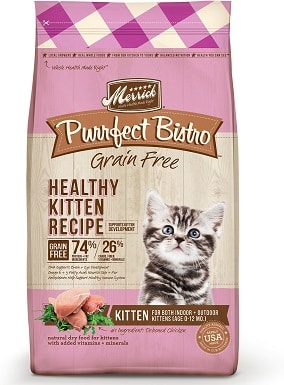
Merrick Purrfect Bistro Grain-Free Healthy Kitten Recipe Dry Food is designed to help kittens look and feel their best. It’s made with 41% protein, most of which comes from real chicken and turkey. This is also packed with healthy and wholesome vegetables that are sourced from local U.S.A. growers. This includes organic alfalfa, sweet potatoes, cranberries, flaxseeds, and salmon oil.
There are plenty of antioxidants, taurine, vitamins, and minerals in this dry food, all designed to provide balanced nutrition for active, growing kittens. While this is grain-free, it does contain both eggs and peas, which can cause digestive upsets or allergies in kittens with sensitive tummies.
- Contains 41% protein
- Chicken and turkey as the first three ingredients
- Made in the U.S.A.
- Contains eggs and peas, which can trigger allergies
- Some kittens don’t like the taste
- Includes flavorings
7. Instinct Original Grain-Free Dry Kitten Food
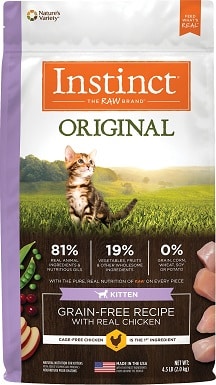
Instinct Original Kitten Grain-Free Recipe Dry Food is inspired by raw food principles and provides maximum digestibility, resulting in your kitten developing a healthy immune system, plus a shiny coat and strong muscles. As well as containing plenty of high-quality protein, this also includes antioxidants, probiotics, and natural omega fatty acids to aid your kitten’s development.
This uses cage-free chicken, which is a great benefit if you’re looking for a wholesome dry kitten food that’s ethically produced. It’s also made in the U.S.A. and contains DHA to help your kitten’s cognitive and eye development. Despite all the excellent ingredients, some kittens don’t like the taste, so it’s worth trying a small bag first.
- Contains 42% protein
- Chicken as the first ingredient
- Contains peas and eggs, which can trigger allergies
- Smells strong
- Some cats don’t like the taste
8. Whole Earth Farms Grain-Free Dry Kitten Food

If you’re looking for a dry kitten kibble that’s grain-free but is also good value for money, the Whole Earth Farms Grain-Free Healthy Kitten Recipe Dry Food is worth considering. This is made in the U.S.A., although it does contain chicken and turkey meal rather than the meat itself.
It also includes salmon oil, potatoes, organic alfalfa, and all the vitamins and minerals that your kitten will need to grow up strong and healthy. It doesn’t contain any meat by-products, artificial colors, flavors, or preservatives. It contains 36% protein, which is the lowest out of all the dry kibble that we have reviewed.
- Good value for money
- Made in the U.S.A.
- Lower in protein than some other options
- Uses chicken and turkey meal, not real meat
- Some cats don’t like the taste
9. Purina Pro Plan Savor Grain-Free Kitten Entree Canned Food
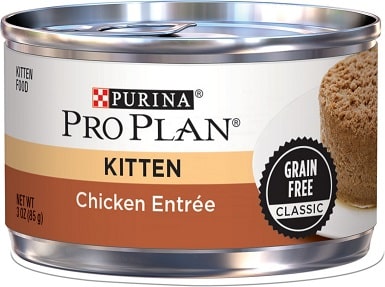
Purina Pro Plan Savor Grain-Free Kitten Entrée Canned Food has been designed to provide all the nutrients and goodness that your kitten needs to thrive. It contains DHA to help brain and eye development, and this nutrient is also found in the mother’s milk, so this is a great wet food to help wean your kitten onto solid food.
This is the only grain-free kitten food that we have reviewed that contains meat by-products. That isn’t necessarily a problem, but some owners prefer to select a food that uses higher quality protein sources, like real meat. This does also contain real meat, but it’s still worth bearing in mind.
- Contains 12% protein
- Real chicken is the first ingredient
- Expensive
- Small can size
- Contains meat by-products
- Contains guar gum
Buyer’s Guide: Selecting the Best Grain-Free Kitten Food
It can be hard to know exactly what to look for when you’re choosing what grain-free food will suit your kitten best, so we’ve put together this buyer’s guide to help you know what to look out for.
First of all, these are the most important features to consider when choosing any kitten food (not just grain-free):
- Complete and balanced nutrition. On the back of any packet of high-quality cat food, it will state that it’s been approved by the Association of American Feed Control Officials (AAFCO) for providing “complete and balanced nutrition.” For kittens, you want to check that the statement reads, “complete and balanced nutrition for the growth stage.” This statement means you can be confident that the food contains a carefully selected blend of proteins, fats, and carbohydrates, as well as all the vitamins, minerals, and supplements that your kitten needs to thrive.
- Protein source. High-quality kitten foods will contain protein as the first ingredient. Look for real meat, rather than meat meal. Meat meal is made from remnants left over from processing, which are then processed at high temperatures before being dehydrated into a powder or “meal.” As you can guess, this doesn’t contain as much goodness as real meat.
- Free from fillers. Fillers are used to bulk out lower-quality kitten foods. Things to watch out for include meat by-products or soybean meal.
- Free from artificial additives. The highest quality grain-free kitten foods won’t include artificial additives like colors, flavorings, or preservatives. Many brands will state that their feeds are free from these additives, so make sure you check the packaging for a statement saying as much.
Kibble or Dry Food?
Whether you choose to feed dry kibble or wet food will be down to personal preference, budget, and your kitten’s likes and dislikes!
Kibble is a great choice for leaving out for your kitten to nibble on throughout the day. It can be a budget-friendly option and is also long-lasting and easy to store. On the downside, kibble usually contains more carbohydrates than wet food and can result in your cat’s water intake not being high enough if fed on its own.
Wet food is extremely palatable and can help kittens stay hydrated due to its high water content. Cats don’t have a high thirst drive, so they can become dehydrated if they only eat kibble. You can use wet food as a topper on kibble or feed it on its own. It’s generally more expensive than kibble, though, and can spoil if left unrefrigerated.
At Catster, we’ve admired Hepper for many years and decided to take a controlling ownership interest so that we could benefit from the outstanding designs of this cool cat company!
Is Grain-Free the Right Choice for My Kitten?
Grain-free cat food doesn’t contain rice, barley, corn, oats, or wheat. It’s often thought that cats have allergies to grains, but they’re actually more likely to suffer from allergies to ingredients like beef, dairy, or fish. Signs of allergies can include:
- Excessive grooming
- Inflamed skin
- Hot spots
- Bald patches
- Itchiness
- Hair loss
- Scabs or sores
If you think that your kitten may have a grain allergy, it’s best to speak to your veterinarian, and they can help you eliminate ingredients like grains from their diet, to see if this makes a difference.
Some kittens thrive extremely well on a grain-free diet, but make sure to do your research regarding allergies if this is your primary reason for going grain-free.
Does Grain-Free Mean Low Carbohydrates Too?
Grain-free might seem like it also has low carbohydrates, but that’s not always the case. Grain-free cat food does contain ingredients like lentils, peas, sweet potatoes, tapioca, and potatoes as carbohydrate sources instead.
Some grain-free kitten foods can actually contain higher levels of carbohydrates than their equivalent versions containing grains. So, if you’re going down the grain-free route to try and keep your kitten’s carbohydrate sources low, then be sure to read the label and find out the carbohydrate content before making your purchase.
Some carbohydrates are important for domestic cats, as they help provide a quick source of energy instead of their body utilizing proteins within their body instead.
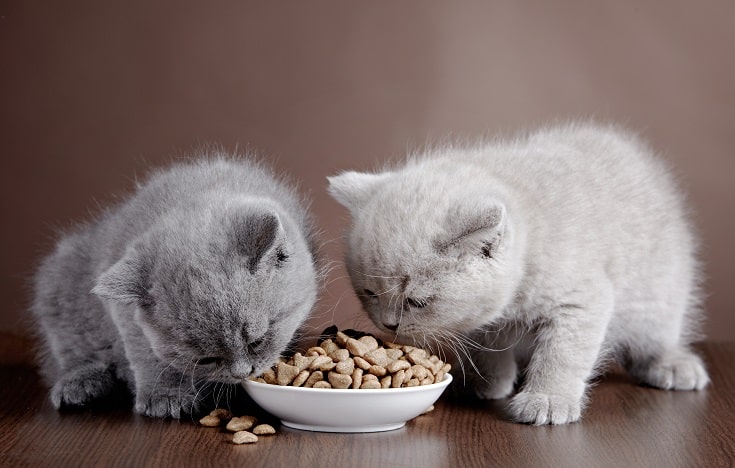
Does Grain-Free Mean High Protein?
Protein is essential for cats, as their primary source of energy. Most grain-free kitten foods do contain high levels of protein from meat, but this isn’t necessarily the correct choice for all kittens. Protein from meat is high in phosphorous, high levels of which have been linked to kidney disease in older cats.
Vegetables are a source of amino acids that can be used to build muscle mass in your kitten’s body, but they’re also low in phosphorous. So, if you’re concerned about the levels of protein in your kitten’s diet, we recommend selecting a grain-free kitten food that contains a blend of vegetables and a protein source from meat.
Is Grain-Free Food Linked to Heart Problems?
No, it’s not. One type of heart disease, dilated cardiomyopathy, can be linked to a deficiency of taurine. That’s one of the reasons that taurine is usually added to commercial kitten foods by manufacturers, so it’s a good idea to check that this is listed on your preferred brand.
Talk to Your Veterinarian
As with any change in diet, it’s always a good idea to speak to your veterinarian before switching foods. As you’ll likely be making appointments for vaccinations and health checks, that’s a great time to ask your veterinarian whether a grain-free diet is going to be the right choice for your kitten in particular.
If the answer is yes, then you can speak to them about which of our grain-free recommendations is going to suit your kitten the best.
Switch to a New Food Gradually
Kittens have delicate digestive systems and can be prone to developing an upset tummy if you introduce a new kitten food too quickly. Once you’ve made your choice and stocked up on your new food, make sure you have some of their old food remaining so you can gradually switch them over. We recommend the following plan:
- Day 1 & 2: 75% old food, 25% new food, well mixed
- Day 3 & 4: 50% old food, 50% new food
- Day 5 & 6: 25% old food, 75% new food
- Day 7: 100% new food
If at any point over the week, your kitten develops an upset tummy, vomits, or has stools that are noticeably different than normal, switch back to their old food and speak to your veterinarian for advice.
Conclusion
As the overall best grain-free kitten food, we selected the Blue Buffalo Wilderness Kitten Grain-Free Dry Food. This well-known brand comes up on top due to the inclusion of real meat and nutrients like DHA and ARA that kittens need to thrive.
In terms of best value, you can’t go wrong with the Iams Perfect Portions Healthy Kitten Grain-Free food. This tasty wet food comes pre-portioned into individual plastic serving trays, so there’s no more fussing with half-empty cans or struggling to pull the lid off!
Hopefully, our reviews have helped you decide on the best grain-free option for your growing kitten. Whichever you choose, they’re all packed with high-quality ingredients and designed to provide all the balanced nutrition that kittens require.
See Also:
Featured Image Credit: Inga Gedrovicha, Shutterstock
Contents
- A Quick Comparison of Our Favorites (Updated in 2024)
- The 9 Best Grain-Free Kitten Foods
- 1. Blue Buffalo Wilderness Kitten Grain-Free Dry Food – Best Overall
- 2. Iams Perfect Portions Healthy Kitten Grain-Free Food – Best Value
- 3. Wellness CORE Grain-Free Kitten Formula Dry Food – Premium Choice
- 4. Earthborn Holistic Monterey Medley Grain-Free Kitten Food
- 5. Wellness Complete Health Kitten Formula Grain-Free Canned Food
- 6. Merrick Purrfect Bistro Grain-Free Healthy Kitten Recipe Dry Food
- 7. Instinct Original Grain-Free Dry Kitten Food
- 8. Whole Earth Farms Grain-Free Dry Kitten Food
- 9. Purina Pro Plan Savor Grain-Free Kitten Entree Canned Food
- Buyer’s Guide: Selecting the Best Grain-Free Kitten Food
- Kibble or Dry Food?
- Is Grain-Free the Right Choice for My Kitten?
- Does Grain-Free Mean Low Carbohydrates Too?
- Does Grain-Free Mean High Protein?
- Is Grain-Free Food Linked to Heart Problems?
- Talk to Your Veterinarian
- Switch to a New Food Gradually
- Conclusion














